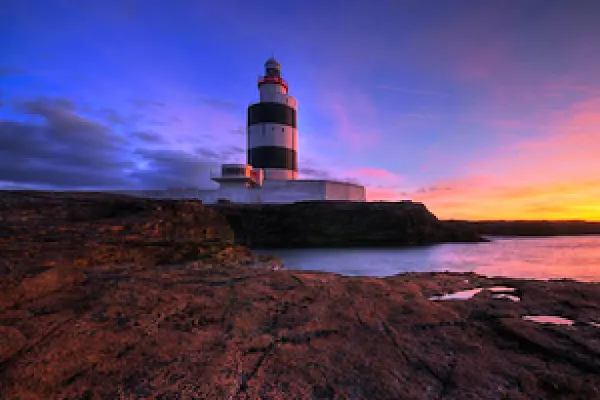Where do you begin when exploring the best attractions in Wexford?
When the weather is good, there is no better place to be with its beautiful beaches, luxurious mountains and wild landscapes. If the weather is not so good, it is a county with plenty of cultural and historical sites to visit.
With all these factors in mind, Hospitality Ireland decided to examine the top ten visitor attractions in Wexford, based on Fáilte Ireland's Visitor Attractions Survey 2022.
1. The Johnstown Castle Estate, Museum And Gardens
(152,547)
The Johnstown Castle Estate, Museum And Gardens is the most visited tourist attraction in Wexford with 152,547 visitors as of 2022.
It was the historic home of two prominent Wexford families, the Esmondes, of Norman descent, arrived in the 12th century but during the Cromwellian era, the estate was confiscated and changed hands before it was acquired by John Grogan in 1692.
Visitors can explore the walled gardens and sculptures along with the lake walks. The Irish Agricultural Museum in the former castle farmyard offers recreated wheelwright workshops, restored tractors, ploughs and threshing machines.
2. The John F Kennedy Arboretum
(137, 419)
The John F. Kennedy Arboretum is dedicated to the memory of John F. Kennedy, 35th President of the United States of America, and is located near New Ross in County Wexford. The visitor centre houses exhibitions and an audiovisual show.
Stretching across 623 acres, the arboretum features over 5,000 types of trees and shrubs planted in botanical sequence, 200 forest plots, rhododendrons, and dwarf conifers.
Attractions include a visitor centre which houses exhibitions on President Kennedy and on the Arboretum itself, signposted walks, and a small islet studded lake.
3. Wells House & Gardens
(75,564)
Wells House was designed by renowned architect Daniel Robertson and visitors can hear about the history of the stately house, walk through beautiful gardens and enjoy family friendly activities.
Visitors are encouraged to relax and take in the beautifully restored terrace gardens based on the original Daniel Robertson plans of the 1830s.
Daniel Robertson was also responsible for the iconic Powerscourt House, County Wicklow and Johnstown Castle, County Wexford.
4. Irish National Heritage Park
(59,524)
The Irish National Heritage Park takes visitors through 9,000 years of history where they can learn about different historical periods on the heritage trails, depicting the first settlements in Ireland up to the arrival of the Normans in the 12th century.
Visitors can choose from Pre-Historic Ireland, Early Christian Ireland or the Age of Invasion, and view replicas of prehistoric campsites, ringforts, crannogs and Viking houses.
The woodland offers ancient trees and pools of water, allowing visitors to experience what Ireland must have looked like to our Stone Age ancestors.
5. Kia Ora Mini Farm
(48,000)
The award winning Kia Ora Mini Farm is a family run open farm with farmyard animals, together with some more unusual ones, such as micropigs, parrots, llamas, emus and alpacas. Children can get to hold and feed animals, operate real diggers and enjoy a ride in a big fire engine.
There is also a maze, milking cow, sandpits, go kart track, crazy football and diggers that adults and children can operate manually.
6. Dunbrody Famine Ship
(40,665)
Dunbrody Famine Ship allows visitors to explore the replica emigrant vessel both above and below deck.
Passengers step back in time as they make their way towards the Quay in New Ross circa 1846. Approaching the ticket office, visual presentations will set the scene of a county in crisis. On board the ship, the tour guide reveals the realities of life on the notorious 'coffin ships.'
Once passengers exit the ship onto the Savannah landing point one of the port destinations for Dunbrody, they learn about life in Savannah in the 1800’s and finally exit through the Irish America Hall of Fame exhibition celebrating the success stories of the Irish in America, such as the Kennedy story.
7. Hook Lighthouse
(36,000)
At Hook Lighthouse, visitors can climb 115 steps to the balcony and enjoy the stunning views of the coastline.
Constructed with local limestone, Hook Lighthouse is one of the oldest operational lighthouses in the world, the present structure dates back 800 years to the medieval tower of Hook.
Fun festivals and family events take place at Hook Lighthouse throughout the year, including the Maritime Matters Festival, the Pirate Festival, Heritage Week Vintage Day and a series of summer lectures.
8. Dunbrody Abbey & Visitor Centre
(20,000)
Founded in 1210, Dunbrody Abbey is an impressive example of a Cistercian monastery in Ireland.
It was founded by Herve de Montmorency in 1170 on the instructions of his nephew Richard de Clare, also known as Strongbow, after the Norman invasion of Ireland.
The abbey was dissolved by Henry VIII in 1536 and granted to the Etchingham family in 1545, at which point part of the church was converted into a residence. A massive collapse occurred on Christmas Eve in 1852, destroying the south wall of the church and some of the monastery.
Next to the abbey lies Dunbrody Castle and a visitor centre opened by the Earl of Belfast, only son of the 7th Marquess of Donegall. The castle gardens feature an intricate yew hedge maze called the Dunbrody Abbey Maze. Made up of 1,500 yew trees and gravel paths, it is one of the only two full size mazes in Ireland.
Today, Dunbrody Abbey retains much of its 13th century church as well as extensive remains of buildings around the cloister garth.
9. Kilmokea Gardens
(20,000)
At Kilmokea Gardens, visitors can learn about the history of the house and garden as well as the Anglo Norman homestead, Viking settlement and monastic site, all of which were once found on the grounds of Kilmokea.
The gardens cover almost seven acres with over 130 different species. Conservatory tea rooms are open March to November.
10. Tintern Abbey
(18, 121)
Tintern Abbey was a Cistercian abbey, founded on the Hook Peninsula around 1200.
The abbey takes its name from Tintern in Wales and was founded by the Earl of Pembroke. It was inhabited by Cistercian monks from a larger abbey at Tintern, Wales, of which the Earl was also a patron.
Today, visitors can view the remains of the nave, chancel, tower, chapel and cloister. There are 45-minute guided tours of the property available, which, in the 16th century, became living quarters for the Colclough family.








